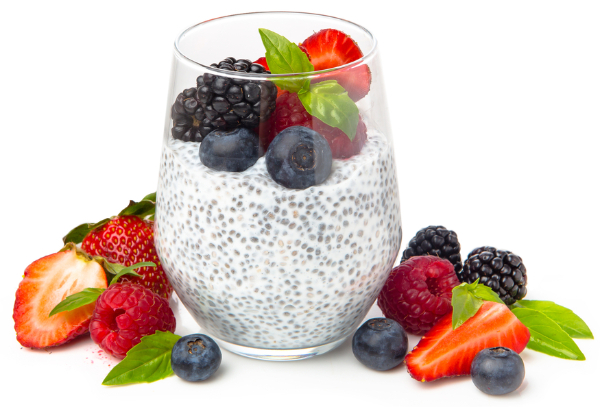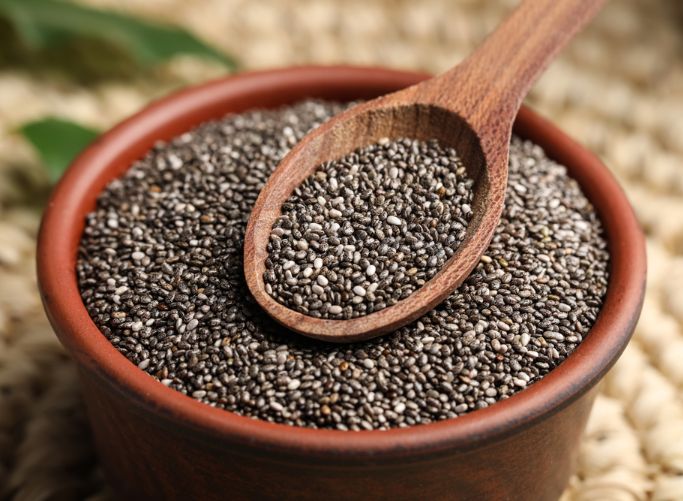What are Chia Seeds?
Chia seeds are small, nutritious seeds that are cultivated in Mexico and Central America. Chia seeds have become popular in recent years because of their health benefits and adaptability in cooking. These small and mighty seeds are full of nutrition such as vitamins, minerals, fiber, healthy fats, proteins and other nutrients. An interesting fact is that during ancient times, chia seeds were actually used as payment in Aztec and Mayan cultures. Chia seeds are not interchangeable with chia pet seeds, because those are inedible. Read on to find out about the nutritional benefits of eating chia seeds and how to include them in your meals.
1. Chia Seeds Are Nutritious
2 tablespoons of chia seeds contain:
- Calories: 138
- Protein: 4.7 grams
- Carbs: 11.9 grams
- Total fat: 8 grams
- Fiber: 9.8 grams
- Sugar: 0 grams
- Calcium: 179 mg
- Potassium: 115 mg
- Omega-3 fatty acids: 5000 mg alpha linolenic acid (ALA)
2. High in Protein
Chia seeds are a rich source of protein. It has almost 5 grams of protein in a 2 tablespoon serving. It is worth noting that chia seeds are a complete source of protein, and have all of the essential amino acids your body needs but cannot make on its own. This is good news for vegans, vegetarians or anyone that is looking for different ways to increase their protein intake.
3. Rich in Omega 3 Fatty Acids
One serving of Chia seeds supplies 5000 mg of omega 3 ALA .That’s a lot of Omega 3s in such a small amount. Omega 3 fatty acids are essential fats that must come from the foods you eat because your body cannot produce them. The three main types of omega-3 fatty acids are: EPA (eicosapentaenoic acid), DHA (docosahexaenoic acid), and ALA (alpha-linoleic acid) . ALA is mostly found in plant-based foods. EPA and DHA are usually found in animal products like salmon, mackerel, and sardines. Omega-3 fatty acids have been associated with numerous health benefits, including: reduced risk of strokes and heart disease, prevent blood clots, reduce inflammation in the body, and brain protective effects.
4. High in Fiber
Chia seeds are full of fiber. A diet with adequate fiber helps with bowel regularity and prevent constipation. It also helps to support a healthy digestive tract. The recommended fiber intake for adults is 25-30 grams daily. A serving of chia seeds supplies close to 40% of this amount, which is impressive.
5. Reduce Blood Sugar Spikes
Chia seeds have been found to slow down the rate of carbohydrate digestion. This may lead to fewer spikes in blood sugar after eating and keep blood glucose levels stable. In fact, it has been found that chia seeds may also have the effect of lowering blood sugar. More studies are needed to see how much it impacts diabetics, especially in those with high blood glucose.
6. Raise HDL Cholesterol
Chia seeds may have cholesterol lowering benefits. Several studies have found that chia seeds reduce LDL (bad) cholesterol while raising HDL (good) cholesterol in people. More of this type of study is needed because these results are not definitive. Adding chia seeds to your diet in combination with other healthy foods may have a positive influence on heart health and lower your chance of heart disease.
Tips on how to use Chia Seeds
The mild yet nutty flavor of chia seeds makes it adaptable to a variety of recipes. It can be used as a thickening agent due to its unique ability to absorb liquids and form into a gel-like substance. Here are some ideas for incorporating chia seeds into your diet:
- Add it to hot cereals like oatmeal, farina, grits
- Incorporate chia seeds in shakes and smoothies
- Use it to make baked goods like muffins, pumpkin bread
- Grind chia seeds into a powder and use it in any dish
- Add it to regular yogurt, or use it as an ingredient in a yogurt bowl
- Mix it with liquids to form a gel and use it as a thickener
- Make energy balls with chia seeds
- Add chia seeds to milk to make chia pudding- see recipe listed below

Vanilla Chia Pudding
This is a basic recipe with ingredients that can easily be swapped for others if you want to change the flavor or consistency of the pudding. You can use any type of milk like regular milk, soymilk, oatmilk, but for a rich and creamy pudding use coconut milk. For a chocolate flavored version substitute the vanilla extract with cinnamon and add 1 tablespoon of unsweetened cocoa powder or cacao.
Ingredients:
1/4 cup chia seeds
1 cup unsweetened almond milk
1 tbsp honey or maple syrup
1/2 tsp vanilla extract
Directions:
In a mason jar, mix together the chia seeds, almond milk, honey or maple syrup, and vanilla extract. Let it sit for 2 minutes. Stir the mixture to make sure the chia seeds are fully incorporated and not clumped together. Cover and refrigerate for at least 30 minutes, or overnight. Top it with strawberries, sliced bananas, crushed nuts, granola or any topping of your choosing.
Makes 1 serving.
References:
- Ferreira, M.del et al. (2020) “Salvia hispanica L. (chia) seed improves skeletal muscle lipotoxicity and insulin sensitivity in rats fed a sucrose-rich diet by modulating intramuscular lipid metabolism,” Journal of Functional Foods, 66, p. 103775. Available at: https://doi.org/10.1016/j.jff.2019.103775.
- De Souza Ferreira C, de Sousa Fomes LD, Espirito Santo da Silva G, Rosa G. Effect of chia seed (Salvia hispanica L.) consumption on cardiovascular risk factors in humans: a systematic review. Nutricion hospitalaria. 2015;32

